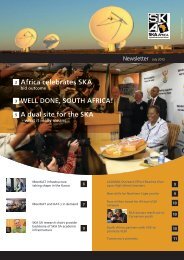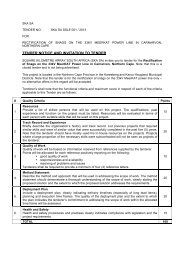Number 19 - March 2013 - SKA
Number 19 - March 2013 - SKA
Number 19 - March 2013 - SKA
You also want an ePaper? Increase the reach of your titles
YUMPU automatically turns print PDFs into web optimized ePapers that Google loves.
S K A N E W S M A R C H 2 0 1 3FOCUS ON HIGH-PERFORMANCESIGNAL PROCESSINGA workshop on high-performance signal processing washeld at the University of Cape Town (UCT) from 28 – 31January <strong>2013</strong>. The workshop, funded by the South African<strong>SKA</strong> Project, provided engineers and scientists with an opportunityto share ideas on the technology underpinninghigh-performance computing, and to present signal processingto young students considering a career in a fieldcritical to the MeerKAT and <strong>SKA</strong>, and to almost everyother high-tech engineering industry.(by Morgan Morris, see3 Communications)I N T E R N A -The <strong>SKA</strong> will not only require super computing power, butalso a daunting level of signal processing, explains FrancoisKapp, the digital back-end subsystems manager onthe MeerKAT project. The processing work will includereceiving, cleaning up or filtering, storing and sorting thesignal received by the atennas, as well as converting thesesignals from analogue to a more useable digital format.A sizeable portion of the technology will be outsourced toindustry, notes Kapp. Luckily, he says, industry andMeerKAT / <strong>SKA</strong> are working off the same script. “Everyone’sscaling up, building supercomputers for a multitudeof applications, of which we (radio astronomy), are just oneapplication.” However, much of the technology has alreadybeen developed in-house by Kapp and his team: notablythe ROACH hardware platform – which the students got touse at the UCT workshop.ROACH, or the Reconfigurable Open Architecture ComputingHardware, is an integrated circuit board developedwithin the Collaboration for Astronomy Signal Processingand Electronics Research (CASPER). The collaboration includesengineers, students and academics from the Universityof California, Berkeley; Caltech; the US NationalRadio Astronomy Observatory; the MeerKAT project team;and the University of Cape Town. ROACH’s standout sellingpoint, other than its significant processing power, is that itcan be configured, or rewired even after it has left the labbench – thus its moniker – to execute different computingtasks. In contrast, traditional computer chips are designedto perform only one or two specific tasks, be it generatinggraphics or running a car’s electronics.Tapping into the latest advances in FPGA integrated-circuittechnology, short for field-programmable gate array,ROACH boards can perform a variety of tasks really well,and super-fast. So much so that ROACH-2, with five timesthe processing capacity of its predecessor, can now befound doing duty in a multitude of instruments in a multitudeof places. By one count, over 300 ROACH boards havebeen deployed at research facilities internationally.Speakers at the UCT signals processing workshop included, from left, JasonManley (DSP team, <strong>SKA</strong> SA), Prof David Davidson (<strong>SKA</strong> SA Research Chair,Stellenbosch University), Prof Justin Jonas (Associate Director for Science andEngineering, <strong>SKA</strong> SA), Prof Mike Inggs (Engineering, UCT), Dr Andrew van derByl (Engineering, UCT), Francois Kapp (DSP, <strong>SKA</strong> SA), Prof Matthew Bailes(Swinburne University, Australia), and Sias Malan MeerKAT(DSP team, <strong>SKA</strong> SA).“The board is now the heart and soul of important radioastronomy instruments all over the world,”– Prof Mike Inggs, one of the hosts of the UCT workshop.The RHINO (reconfigurable hardwareinterface for computing and radio)platform is a pared-downversion of the ROACH boardsbeing developed by the SoftwareDefined Radio Group atUCT. It is a cheaper versionof ROACH, designed fortraining in reconfigurablecomputing, rather than forrunning specialised instruments,explains Inggs.The workshop, notes co-host, UCTresearch officer Dr Andrew van derByl, exposed the engineering and astronomyworlds to both signal processing and reconfigurablecomputing. It also helped to entice students into a fieldthat, thanks to MeerKAT and the <strong>SKA</strong> projects, will keepscience and industry busy for years. Especially as the workof radio astronomy and signals processing – its hardwareand algorithms – can be applied to the likes of telecommunications,radar, encryption, even banking.“The way things are going, there are always new avenuesto explore and new things to do.” – Dr Andrew van der Byl, UCT








